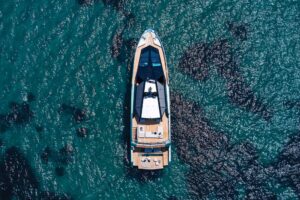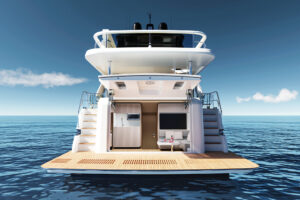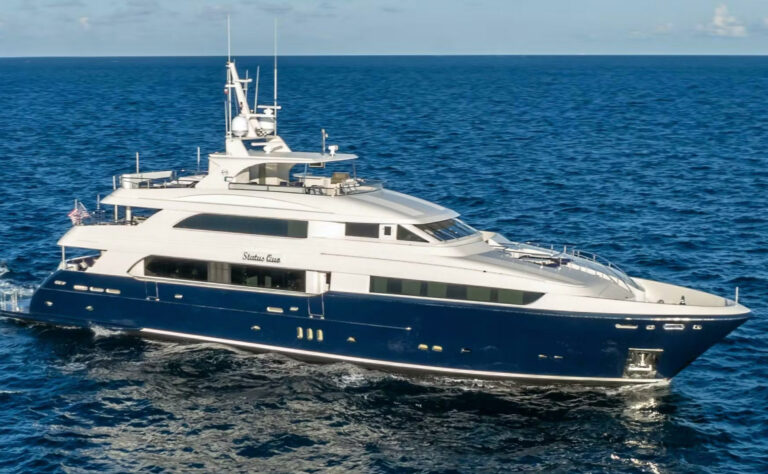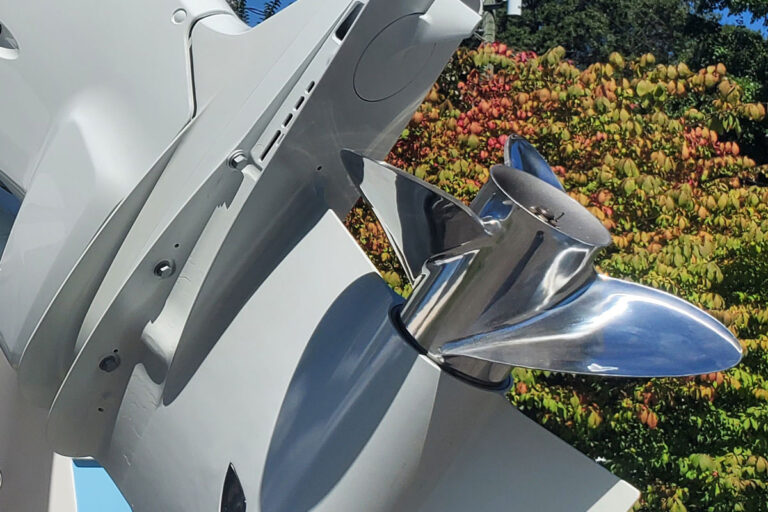Custom sailing yachts succeed or fail on the whims of the client and the design team’s ability to interpret those whims. You’ll find proof of this in the many yachts that appear for sale within a year of launching, and later wind up in rehab yards. Once-proud yachts, having displeased their owners, suffer the ignominy of gutted accommodations and altered deck layouts.
I’ll wager that Whisper won’t suffer this fate. Sensitively conceived and expertly rendered, she transcends the ebb and flood of the sterile minimalist styling found in some high-performance cruisers. Though her appearance abovedecks and below recalls elements of designs from the early 20th century, her performance and systems live in the 21st. Anyone who doubts Whisper‘s place among the great yachts need only spend 15 minutes at the helm while she sails herself on a reach at 12 knots. Almost as entertaining: Wedge yourself in place on the leeward side with your feet against the bulwarks and your back pressed to the trunk cabin, and watch the water rush aft while a 25-knot gust tries in vain to drive the rail into the maelstrom. Still don’t get it? Relax in the saloon and listen to the hull’s susurrous interaction with the water while you read your favorite book.
Whisper succeeds in her mission, because the owner knew what he wanted from the yacht. Although she coincidentally attests to her owner’s financial success, her carefree hospitality and reassuring manners at sea tell us that he loves to sail, has an abiding respect and appreciation of yachting’s history and truly enjoys sharing his passion with friends and family. These are the main reasons everyone feels so at home aboard Whisper. To help him achieve his goals for the yacht, he had the sense to commission Fontaine Design Group (formerly Hood Design Group, with Ted Fontaine as chief designer) for the naval architecture and exterior styling, Andrew Winch for the interior and Holland Jachtbouw for the flawless execution.
Though Whisper counts Pamina, Surama and Savannah among her immediate antecedents, she exhibits a character all her own. Compared with her sisters, she has a shallower canoe body and firmer bilges, though her sections retain a wineglass shape. Fontaine cut away the forefoot to quicken her response in tacks and jibes, then hollowed and sharpened it to ease her progress through the seas. In spite of her relatively shallow draft, Whisper carries her ballast low enough to stand up to her powerful four-spreader rig, which finally reached about 10 feet higher than it might have. During discussions about the rig, the owner took Ted Hood’s advice: When in doubt, go up. Whisper spreads nearly 7,500 square feet of sail area (main, genoa and staysail) and has a better sail area-to-displacement ratio than the typical Delta form that Fontaine has done in the past. The actual digits, though valuable for arcane yacht-to-yacht comparisons, say nothing about the feel of her performance.
I sailed Whisper on Narragansett Bay, off Newport, Rhode Island. In addition to Capt. Don Lessels and crew, a handful of cheerful people from Little Harbor Yacht Brokers and Little Harbor Yacht Charters joined me. To my surprise and delight, Hood, Fontaine and the owner (who asked that his name be withheld) also graced the sea trial. Although the wind mainly blew into the bay from the open ocean, it fenced with the skill of D’Artagnan, bending its way among the islands, the bridge, and the steep headland on the north side of the entrance to the bay. The true wind speed varied from a low of 10 knots to a high of 20. Whisper showed speeds of 8 to 13 knots.
Feint and thrust, feint and thrust-the wind tested Whisper‘s reflexes, and she responded with the agility of a much shorter and lighter boat. The distribution of volume below the waterline is only partly responsible for her athletic moves. We have to credit the effective centerboard and rudder for their share. Though Whisper draws 8 feet, 3 inches with the board retracted, it adds nearly 12 feet to the draft when it’s deployed. The rudder also has a retracting daggerboard, to increase its bite on the water.
Even if she won’t tack and jibe with a featherweight grand prix maxi, she steers like one. In fact, Whisper has the same type of cable-and-quadrant steering system used on many of the Volvo 60s. Light in feel (for a boat of this length and displacement) and remarkably accurate, the steering contributes a lot to the perception of agility. Unlike the numbness of hydraulic systems, Whisper‘s steering telegraphs the rudder’s every move.
Southern Spars built the carbon-fiber spars. The main rolls into the boom, and each headsail reefs and furls on a roller. A battery of seven hydraulic winches, located around a shallow cockpit abaft the helm, takes care of the sail handling. The mainsail sheets to a winch immediately to port of the companionway leading to the owner’s stateroom. Each winch, save the two massive primaries at the after end of the trimmer’s cockpit, has adjacent to it a sheet fall built into the deck.
An anthropologist uncovering Whisper in the next millennium would likely regard her cockpits as socially conscious. All sail handling occurs abaft the helm, even a safe distance from the pair of chaise lounges that often resides on the afterdeck. The real social center abovedecks is the large cockpit forward of the helm. At sea, it’s close enough to the helm to keep the owner in touch with his guests when he’s driving. At anchor, it becomes a spacious focal point for meals, cocktails, lively conversation and lounging. A barrel chair at the after end of each table completes the C-shape of both dinettes. Both chairs swivel 360 degrees and lock at a variety of compass points. Adding music to this arrangement will carry the party into the wee hours.
In the temperate zones of the world, a chill in the air may send the party below. Whisper‘s guests could hardly regard the change of venue as a sentence. They’ll enter the pilothouse, stopping for drinks at the bar on the port side. Light from beneath the alabaster counter warms the guests even before cognac touches their lips. The ambience could seduce anyone who’s still breathing.
An open banister separates the upper saloon from the lower, promoting the feeling of spaciousness-a characteristic also physically abundant. On bright days, light from the portlights, hatches and large windows in the pilothouse set the areas ablaze with cheer. Thoughtfully placed electric lighting ought to be a fine substitute when the clouds hide the sun. The lighting offers occupants of the main saloon a variety of moods.
If the party runs too far into the next day, Mr. and Mrs. Owner can retreat to the master stateroom, way back aft. There, they can read or sleep in peace, no matter the ruckus from the common areas, because they are half the LOA away from the party and very well insulated against the transmission of noise and vibration. The four guest staterooms between the main saloon and the master fare less well, being closer to the party, but their occupants are still socializing.
Whisper will earn part of her keep in the charter trade, and she’s perfect for the job. The business end of the yacht occupies the forward third of the hull. There, we find the galley, captain’s stateroom and head, crew mess and a pair of over/under double staterooms, each with a private head.
The owner’s brief for Whisper stated a leisurely circumnavigation of the planet as the ultimate goal. To that end, all of her systems are modern and efficient, but none is necessarily cutting edge-and definitely not unproven. If anything malfunctions, the skipper ought to be able to get it repaired anywhere in the world. Whisper‘s aluminum hull will fend off impacts that would likely fracture a lightweight composite structure, and if she suffers a breach, finding someone to weld aluminum will be easier than finding a yard that can repair a high-tech laminate.
My short time aboard Whisper will stay with me for a long time to come. As her charter guests will discover, she’s one of the warmest and friendliest custom yachts afloat, and more than worth the $50,000-per-week fee. Though the owner said he may have to fire himself to find time to enjoy all of Whisper‘s fine qualities, let us prospective charter clients hope he waits a little while before he does so.
Contact: Holland Jachtbouw, (011) 31 75 614 91 33; www.hollandjachtbouw.nl. Fontaine Design Group, (401) 682-9101. For more information, contact: (866) 922-4877; www.yachtingnet.com/yachting/productinfo.









